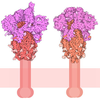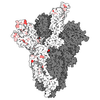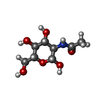[English] 日本語
 Yorodumi
Yorodumi- PDB-9mv0: Structure of HKU5 spike C-terminal domain in complex with ACE2 fr... -
+ Open data
Open data
- Basic information
Basic information
| Entry | Database: PDB / ID: 9mv0 | ||||||
|---|---|---|---|---|---|---|---|
| Title | Structure of HKU5 spike C-terminal domain in complex with ACE2 from Pipistrellus abramus | ||||||
 Components Components |
| ||||||
 Keywords Keywords | VIRAL PROTEIN / Immune system / ACE2 / bat coronavirus / merbecovirus / HKU5 | ||||||
| Function / homology |  Function and homology information Function and homology informationHydrolases; Acting on peptide bonds (peptidases) / peptidyl-dipeptidase activity / carboxypeptidase activity / metallopeptidase activity / host cell endoplasmic reticulum-Golgi intermediate compartment membrane / receptor-mediated virion attachment to host cell / cilium / apical plasma membrane / endocytosis involved in viral entry into host cell / fusion of virus membrane with host plasma membrane ...Hydrolases; Acting on peptide bonds (peptidases) / peptidyl-dipeptidase activity / carboxypeptidase activity / metallopeptidase activity / host cell endoplasmic reticulum-Golgi intermediate compartment membrane / receptor-mediated virion attachment to host cell / cilium / apical plasma membrane / endocytosis involved in viral entry into host cell / fusion of virus membrane with host plasma membrane / fusion of virus membrane with host endosome membrane / viral envelope / host cell plasma membrane / virion membrane / proteolysis / extracellular space / metal ion binding / membrane / cytoplasm Similarity search - Function | ||||||
| Biological species |  Pipistrellus abramus (Japanese house bat) Pipistrellus abramus (Japanese house bat) Pipistrellus bat coronavirus HKU5 Pipistrellus bat coronavirus HKU5 | ||||||
| Method | ELECTRON MICROSCOPY / single particle reconstruction / cryo EM / Resolution: 4.2 Å | ||||||
 Authors Authors | Li, N. / Tsybovsky, Y. / Teng, I. / Zhou, T. | ||||||
| Funding support |  United States, 1items United States, 1items
| ||||||
 Citation Citation |  Journal: Nat Commun / Year: 2025 Journal: Nat Commun / Year: 2025Title: HKU5 bat merbecoviruses engage bat and mink ACE2 as entry receptors. Authors: Mia Madel Alfajaro / Emma L Keeler / Ning Li / Nicholas J Catanzaro / I-Ting Teng / Zhe Zhao / Michael W Grunst / Boyd Yount / Alexandra Schäfer / Danyi Wang / Arthur S Kim / Aleksandra ...Authors: Mia Madel Alfajaro / Emma L Keeler / Ning Li / Nicholas J Catanzaro / I-Ting Teng / Zhe Zhao / Michael W Grunst / Boyd Yount / Alexandra Schäfer / Danyi Wang / Arthur S Kim / Aleksandra Synowiec / Mario A Peña-Hernández / Samantha Zepeda / Ridwan Arinola / Ramandeep Kaur / Bridget L Menasche / Jin Wei / Gabriel A Russell / John Huck / Jaewon Song / Aaron Ring / Akiko Iwasaki / Rohit K Jangra / Sanghyun Lee / David R Martinez / Walther Mothes / Pradeep D Uchil / John G Doench / Alicen B Spaulding / Ralph S Baric / Leonid Serebryannyy / Yaroslav Tsybovsky / Tongqing Zhou / Daniel C Douek / Craig B Wilen /   Abstract: Identifying receptors for bat coronaviruses is critical for spillover risk assessment, countermeasure development, and pandemic preparedness. While Middle East respiratory syndrome coronavirus (MERS- ...Identifying receptors for bat coronaviruses is critical for spillover risk assessment, countermeasure development, and pandemic preparedness. While Middle East respiratory syndrome coronavirus (MERS-CoV) uses DPP4 for entry, the receptors of many MERS-related betacoronaviruses remain unknown. The bat merbecovirus HKU5 was previously shown to have an entry restriction in human cells. Using both pseudotyped and full-length virus, we show that HKU5 uses Pipistrellus abramus bat ACE2 but not human ACE2 or DPP4 as a receptor. Cryo-electron microscopy analysis of the virus-receptor complex and structure-guided mutagenesis reveal a spike and ACE2 interaction that is distinct from other ACE2-using coronaviruses. MERS-CoV vaccine sera poorly neutralize HKU5 informing pan-merbecovirus vaccine design. Notably, HKU5 can also engage American mink and stoat ACE2, revealing mustelids as potential intermediate hosts. These findings highlight the versatility of merbecovirus receptor use and underscore the need for continued surveillance of bat and mustelid species. | ||||||
| History |
|
- Structure visualization
Structure visualization
| Structure viewer | Molecule:  Molmil Molmil Jmol/JSmol Jmol/JSmol |
|---|
- Downloads & links
Downloads & links
- Download
Download
| PDBx/mmCIF format |  9mv0.cif.gz 9mv0.cif.gz | 374.9 KB | Display |  PDBx/mmCIF format PDBx/mmCIF format |
|---|---|---|---|---|
| PDB format |  pdb9mv0.ent.gz pdb9mv0.ent.gz | 277.6 KB | Display |  PDB format PDB format |
| PDBx/mmJSON format |  9mv0.json.gz 9mv0.json.gz | Tree view |  PDBx/mmJSON format PDBx/mmJSON format | |
| Others |  Other downloads Other downloads |
-Validation report
| Summary document |  9mv0_validation.pdf.gz 9mv0_validation.pdf.gz | 1.4 MB | Display |  wwPDB validaton report wwPDB validaton report |
|---|---|---|---|---|
| Full document |  9mv0_full_validation.pdf.gz 9mv0_full_validation.pdf.gz | 1.5 MB | Display | |
| Data in XML |  9mv0_validation.xml.gz 9mv0_validation.xml.gz | 63 KB | Display | |
| Data in CIF |  9mv0_validation.cif.gz 9mv0_validation.cif.gz | 94.1 KB | Display | |
| Arichive directory |  https://data.pdbj.org/pub/pdb/validation_reports/mv/9mv0 https://data.pdbj.org/pub/pdb/validation_reports/mv/9mv0 ftp://data.pdbj.org/pub/pdb/validation_reports/mv/9mv0 ftp://data.pdbj.org/pub/pdb/validation_reports/mv/9mv0 | HTTPS FTP |
-Related structure data
| Related structure data |  48650MC M: map data used to model this data C: citing same article ( |
|---|---|
| Similar structure data | Similarity search - Function & homology  F&H Search F&H Search |
- Links
Links
- Assembly
Assembly
| Deposited unit | 
|
|---|---|
| 1 |
|
- Components
Components
| #1: Protein | Mass: 92874.102 Da / Num. of mol.: 2 Source method: isolated from a genetically manipulated source Source: (gene. exp.)  Pipistrellus abramus (Japanese house bat) Pipistrellus abramus (Japanese house bat)Cell line (production host): EXPI / Production host:  Homo sapiens (human) Homo sapiens (human)References: UniProt: C7ECT9, Hydrolases; Acting on peptide bonds (peptidases) #2: Protein | Mass: 149814.000 Da / Num. of mol.: 2 Source method: isolated from a genetically manipulated source Source: (gene. exp.)  Pipistrellus bat coronavirus HKU5 / Gene: S, 2 / Cell line (production host): EXPI / Production host: Pipistrellus bat coronavirus HKU5 / Gene: S, 2 / Cell line (production host): EXPI / Production host:  Homo sapiens (human) / References: UniProt: A3EXD0 Homo sapiens (human) / References: UniProt: A3EXD0#3: Polysaccharide | 2-acetamido-2-deoxy-beta-D-glucopyranose-(1-4)-2-acetamido-2-deoxy-beta-D-glucopyranose #4: Sugar | ChemComp-NAG / Has ligand of interest | N | Has protein modification | Y | |
|---|
-Experimental details
-Experiment
| Experiment | Method: ELECTRON MICROSCOPY |
|---|---|
| EM experiment | Aggregation state: PARTICLE / 3D reconstruction method: single particle reconstruction |
- Sample preparation
Sample preparation
| Component | Name: ACE2-ACT66266.1 in complex with HKU5-CTD (ABN10875) / Type: COMPLEX / Entity ID: #1-#2 / Source: MULTIPLE SOURCES |
|---|---|
| Molecular weight | Value: 0.16 MDa / Experimental value: NO |
| Source (natural) | Organism:  Pipistrellus abramus bat coronavirus HKU5-related Pipistrellus abramus bat coronavirus HKU5-related |
| Source (recombinant) | Organism:  Homo sapiens (human) Homo sapiens (human) |
| Buffer solution | pH: 8 |
| Specimen | Conc.: 3.7 mg/ml / Embedding applied: NO / Shadowing applied: NO / Staining applied: NO / Vitrification applied: YES |
| Specimen support | Grid material: GOLD / Grid mesh size: 200 divisions/in. / Grid type: Quantifoil R2/2 |
| Vitrification | Instrument: FEI VITROBOT MARK IV / Cryogen name: ETHANE / Humidity: 95 % / Chamber temperature: 277.15 K |
- Electron microscopy imaging
Electron microscopy imaging
| Experimental equipment |  Model: Titan Krios / Image courtesy: FEI Company |
|---|---|
| Microscopy | Model: TFS KRIOS |
| Electron gun | Electron source:  FIELD EMISSION GUN / Accelerating voltage: 300 kV / Illumination mode: FLOOD BEAM FIELD EMISSION GUN / Accelerating voltage: 300 kV / Illumination mode: FLOOD BEAM |
| Electron lens | Mode: BRIGHT FIELD / Nominal magnification: 47000 X / Nominal defocus max: 1900 nm / Nominal defocus min: 500 nm / Cs: 2.7 mm / C2 aperture diameter: 50 µm |
| Specimen holder | Cryogen: NITROGEN / Specimen holder model: FEI TITAN KRIOS AUTOGRID HOLDER |
| Image recording | Average exposure time: 2 sec. / Electron dose: 40 e/Å2 / Film or detector model: DIRECT ELECTRON APOLLO (4k x 4k) / Num. of grids imaged: 1 / Num. of real images: 10702 |
| Image scans | Width: 4096 / Height: 4096 |
- Processing
Processing
| EM software |
| ||||||||||||||||||||||||||||||||||||||||||||||||||||
|---|---|---|---|---|---|---|---|---|---|---|---|---|---|---|---|---|---|---|---|---|---|---|---|---|---|---|---|---|---|---|---|---|---|---|---|---|---|---|---|---|---|---|---|---|---|---|---|---|---|---|---|---|---|
| CTF correction | Type: PHASE FLIPPING AND AMPLITUDE CORRECTION | ||||||||||||||||||||||||||||||||||||||||||||||||||||
| Particle selection | Num. of particles selected: 2125866 | ||||||||||||||||||||||||||||||||||||||||||||||||||||
| Symmetry | Point symmetry: C2 (2 fold cyclic) | ||||||||||||||||||||||||||||||||||||||||||||||||||||
| 3D reconstruction | Resolution: 4.2 Å / Resolution method: FSC 0.143 CUT-OFF / Num. of particles: 242675 / Num. of class averages: 1 / Symmetry type: POINT | ||||||||||||||||||||||||||||||||||||||||||||||||||||
| Refinement | Highest resolution: 4.2 Å Stereochemistry target values: REAL-SPACE (WEIGHTED MAP SUM AT ATOM CENTERS) | ||||||||||||||||||||||||||||||||||||||||||||||||||||
| Refine LS restraints |
|
 Movie
Movie Controller
Controller


 PDBj
PDBj



